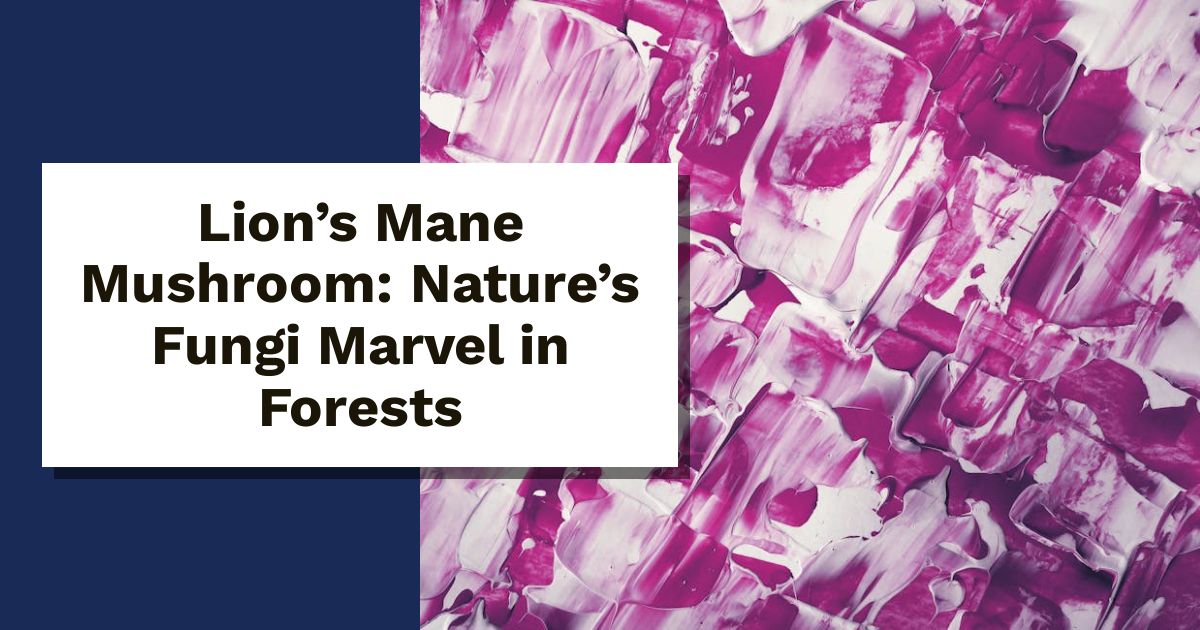Imagine walking through a forest where every tree holds a secret. Among them, Lion’s Mane mushrooms stand out with their fluffy, white appearance and fascinating traits. But they’re not just foraged delicacies; they play an important role in forest ecology.
Lion’s Mane mushrooms help break down dead trees, returning valuable nutrients to the soil. This keeps the ecosystem healthy and thriving. They even form partnerships with other plants, helping them absorb more water and minerals.
In this post, we’ll uncover the ecological significance of Lion’s Mane and highlight its unique characteristics. Whether you’re a nature lover or a mushroom enthusiast, you’ll gain insights into why this fungi marvel is vital for our forests. Get ready to explore the enchanting world of Lion’s Mane!
What is Lion’s Mane Mushroom?
Lion’s Mane mushroom, scientifically known as Hericium erinaceus, is a fascinating fungus known for its striking appearance and valuable ecological role. Easily recognizable for its unique, shaggy look, Lion’s Mane adds intrigue as it thrives in forest environments. Let’s dive into its physical characteristics and growth habits to see why this mushroom deserves your attention.
Physical Characteristics
Lion’s Mane mushrooms are hard to miss. Their distinct features make them stand out in the forest. Here are some key characteristics:
- Appearance: These mushrooms have a fluffy, white exterior with long, cascading spines resembling a lion’s mane. As they age, the color may shift to yellowish or brownish hues.
- Size: They can grow quite large, reaching up to 12 inches in diameter. Their odd, round shape and fuzzy texture distinguish them from other fungi.
- Texture: The spines are soft and delicate, giving a unique feel when touched. They exude a moist, fresh scent, reminiscent of the forest.
Curious about more details? Check this Lion’s Mane Mushroom Guide.
Growth Habits
Lion’s Mane mushrooms flourish primarily on decaying hardwoods, especially beech, oak, and maple. They are often found in clusters on dead or dying trees, playing a crucial role in breaking down organic matter. Here’s how they grow:
- Habitat: These mushrooms typically thrive in temperate forests. You can spot them on logs, stumps, and trunks, especially in shaded areas that retain moisture.
- Lifecycle: They usually fruit in late summer to early fall. The fruiting body develops from mycelium that colonizes the wood, extracting nutrients from the decaying structure.
- Growth Timeline: If you’ve ever thought about cultivating them, expect to wait one to two years after inoculation on logs before harvesting your first batch. Patience is key!
For a detailed guide on how to grow Lion’s Mane mushrooms, check out this resource on Growing Lion’s Mane Mushrooms.
Lion’s Mane is more than just a pretty mushroom. Its physical features and growth habits reflect its role in maintaining the delicate balance of forest ecosystems. Exploring these fascinating elements reveals why this fungus is considered a marvel of nature.
Role in Forest Ecosystems
Lion’s Mane mushrooms are not just eye-catching; they play a fundamental role in forest ecosystems. These fungi contribute to nutrient cycling, support plant life, and offer sustenance to various wildlife. Let’s break down their essential functions in the environment.
Decomposer Function
Lion’s Mane mushrooms act as nature’s recyclers. They thrive on dead or decaying wood, breaking it down into simpler substances. Through this process, they:
- Recycle Nutrients: Lion’s Mane extracts nutrients from organic matter, returning them to the soil. This nourishment supports new plant growth.
- Promote Soil Health: By decomposing material, they enrich the soil, helping to sustain the entire ecosystem.
- Enhance Biodiversity: Their activity creates a welcoming environment for other organisms, fostering a rich community of life.
For more insights about their role, check out this Lion’s Mane Mushroom Benefits.
Symbiotic Relationships
Lion’s Mane mushrooms are skilled at forming partnerships with trees. This symbiosis benefits both parties:
- Water and Nutrient Exchange: Lion’s Mane can help trees absorb more water and essential minerals. In return, trees provide sugars and nutrients to the fungi.
- Support for Growth: This partnership promotes the health of both the fungi and the trees. It allows them to thrive in environments that may otherwise be less favorable.
- Sustainability: Such interactions are crucial for maintaining balanced ecosystems, like healthy forests.
To learn more about these vital relationships, explore this article on Mushrooms and Their Relationships with Trees.
Food Source for Wildlife
Lion’s Mane mushrooms aren’t just beneficial to plants; they are also a food source for a variety of animals. Here’s how they contribute to local wildlife diets:
- Attract Various Species: Animals like deer, squirrels, and insects are drawn to Lion’s Mane. These mushrooms provide essential nutrients, especially in areas where other food sources may be scarce.
- Support the Food Chain: By serving as a food source, Lion’s Mane helps maintain the balance of local ecosystems. It supports not just herbivores but also carnivores that prey on those herbivores.
- Nutrient-Rich Snack: Many creatures benefit from the nutrients found in these mushrooms, promoting their health and growth.
Interested in how wildlife interacts with Lion’s Mane? Check this insightful post on Ultimate Guide to Foraging Lion’s Mane.
Lion’s Mane mushrooms are more than just a unique sight in the forest. Their contributions to decomposition, symbiotic relationships, and wildlife nourishment illustrate their importance in maintaining healthy forest ecosystems. Exploring these aspects reveals just how integral this fungus is to the natural world.
Human Interaction with Lion’s Mane
Lion’s Mane mushrooms are not just captivating in their natural habitat; they also have a remarkable culinary and health profile that has piqued our interest. From delicious recipes to amazing health benefits, these fungi have carved out a wonderful spot in kitchens and wellness routines.
Culinary Use
Cooking with Lion’s Mane mushrooms is an adventure in flavor and texture. These fungi have a mild, slightly sweet taste that lends itself well to various dishes. Here are some creative ways to elevate your meals using Lion’s Mane:
- Sautéed Slices: A simple sauté in butter or olive oil brings out their meaty texture. Check out this 10-Minute Lion’s Mane Mushroom Recipe for a quick dish that pairs well with any meal.
- Mushroom Steaks: Turn Lion’s Mane into hearty steaks! You can grill or pan-sear them with a balsamic glaze for a gourmet experience. Explore this delicious recipe for Lion’s Mane Mushroom Steaks with Balsamic Pan Sauce.
- Simple Sauté: If you prefer something straightforward, this Simple Lion’s Mane Mushroom Recipe is buttery, meaty, and packed with flavor.
- Gourmet Dishes: Want to impress guests? Consider incorporating them into risottos, stir-fries, or even tacos. Check out 13 Flavorful Lion’s Mane Recipes for more inspiration.
These culinary methods show how easy it is to incorporate Lion’s Mane mushrooms into your meals, making your dining experience more adventurous.
Health Benefits
Lion’s Mane mushrooms are not only delicious; they also pack a punch when it comes to health benefits. Research has highlighted several ways these mushrooms can contribute to your well-being:
- Cognitive Health: Studies suggest that Lion’s Mane may protect against dementia and promote brain health. It might even help repair nerve damage. For a deep dive into the research, check this article on Health Benefits of Lion’s Mane Mushroom.
- Mood Improvement: There’s evidence to indicate Lion’s Mane could help alleviate symptoms of anxiety and depression. This makes them a natural choice for those seeking mental wellness.
- Immune Support: These mushrooms contain probiotics that can boost your immune system and support gut health. Learn more about these benefits at Cleveland Clinic.
- Rich in Nutrients: Lion’s Mane mushrooms provide essential vitamins such as thiamine, riboflavin, and minerals like manganese and zinc. For more details on their nutritional profile, visit WebMD.
Exploring these health benefits highlights why Lion’s Mane mushrooms deserve a cherished place in both our kitchens and our diets. Whether you’re looking to spice up your meals or improve your health, these mushrooms offer ample opportunities.
Conservation and Sustainability
Lion’s Mane mushrooms are not just fascinating fungi; they need our protection too. Various threats challenge their habitat, impacting their survival. Understanding these threats and how we can promote sustainability is crucial for preserving these beautiful mushrooms and the forests they inhabit.
Threats to Habitat
Lion’s Mane populations face numerous environmental challenges. Here are some significant threats they encounter:
- Deforestation: As forests shrink due to logging and urban expansion, Lion’s Mane mushrooms lose their homes.
- Climate Change: Rising temperatures and unpredictable weather patterns disrupt growth. Changes in moisture levels can be detrimental to their development.
- Pollution: Contaminants from industrial activities infiltrate forest ecosystems, affecting the health of mushrooms and the soil.
- Overharvesting: People foraging for Lion’s Mane can inadvertently lead to population declines if not done responsibly. Unscrupulous collectors can take too much from a single area. Learn more about this threat in detailed articles.
- Invasive Species: Non-native plants and pests can outcompete local flora, disrupting the delicate balance needed for Lion’s Mane to thrive.
These threats remind us of the importance of preservation.
How to Promote Sustainability
There are several simple yet effective ways to support the sustainability of Lion’s Mane mushrooms and their forest habitats:
- Practice Responsible Foraging: If you forage for Lion’s Mane, ensure you only take what you need and leave the rest for nature.
- Support Sustainable Sources: Purchase Lion’s Mane mushrooms from certified sustainable farms. This helps keep habitats healthy.
- Reduce Pollution: Be mindful of your environmental footprint. Support clean energy and sustainable practices to protect forests.
- Maintain Forest Health: Participate in local conservation efforts. This includes tree planting or supporting organizations that work to protect forests.
- Raise Awareness: Educate others about the ecological significance of mushrooms, including Lion’s Mane. Share useful resources and information to create a more informed community.
Interested in more ways to support these fungi? Check out this guide on mushroom sustainability.
By understanding the threats to their habitat and taking steps toward sustainability, we can ensure that Lion’s Mane mushrooms continue to flourish in our forests. Each action counts in preserving not only these incredible fungi but the entire forest ecosystem as well.
Conclusion
Lion’s Mane mushrooms are essential players in forest ecology. They break down dead wood, recycle nutrients, and support healthy soil. Their partnerships with trees enhance both plant and fungi growth, creating a vibrant ecosystem.
As we appreciate these unique fungi, let’s also commit to protecting their habitats. Every effort counts, whether it’s responsible foraging or supporting sustainable practices. By valuing Lion’s Mane, we help ensure these fascinating mushrooms continue to thrive among the trees.
So, next time you stroll through the woods, take a moment to admire the Lion’s Mane. They are more than just mushrooms; they are integral to the forest’s dance of life.
Dr. Cordy is a passionate advocate for the incredible benefits of Lion's Mane mushrooms, blending scientific insight with a deep enthusiasm for natural wellness. When he’s not exploring the latest research on functional fungi, you’ll find him chasing waves as an avid surfer, strategizing over chess matches, or embarking on outdoor adventures that fuel his curiosity and love for nature. A devoted dog dad and lifelong explorer, Dr. Cordy combines his diverse passions with a mission to educate and inspire others about the transformative potential of Lion’s Mane mushrooms. You can unearth his latest Lion's Mane insights here. 🍄


